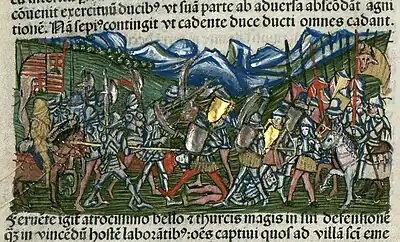| Battle of Hermannstadt | |||||||
|---|---|---|---|---|---|---|---|
| Part of the Ottoman wars in Europe Ottoman-Hungarian Wars | |||||||
 The battle of John Hunyadi at Szeben (Chronica Hungarorum, 1488) | |||||||
| |||||||
| Belligerents | |||||||
|
|
| ||||||
| Commanders and leaders | |||||||
|
John Hunyadi György Lépes † | Mezid Bey † | ||||||
| Strength | |||||||
| Unknown | 16,000 men | ||||||
The Battle of Hermannstadt, also known as the Battle of Sibiu or the Battle of Szeben, was fought between the army of the Hungarian Kingdom and the Ottoman Empire on March 18 and March 22, 1442, near Marosszentimre and Hermannstadt (Szeben), modern Sântimbru and Sibiu, Romania. The Hungarian forces were commanded by John Hunyadi. Hermannstadt was Hunyadi's third victory over the Ottomans after the relief of Smederevo in 1437 and the defeat of Ishak Beg midway between Semendria and Belgrade in 1441.
Background
In 1438 Ottoman marauders attacked Transylvania, where in 1437 the Ottomans had been beaten by an uprising under Antal Nagy de Buda. For up to 45 days the Ottomans without let or hindrance attacked the Transylvanian Saxon lands and Hungarian villages and market towns.[2]
In 1441 John Hunyadi came to power. Hunyadi attacked the Ottomans in Serbia and at the Battle of Smederevo got the best of Ishak bey. The Ottoman Sultan, Murad II, proclaimed in the autumn of 1441 that a raid into Hungarian Transylvania would take place in March 1442.[2] In early March 1442, the marcher lord Mezid Bey led 16,000 akinji cavalry raiders into Transylvania, crossing the Danube to Wallachia at Nicopolis and marching north in formation.[3]
Battle
On March 18 bishop György Lépes' forces (2,000 men) clashed with Mezid near Sântimbru. The Ottomans won by forces of numbers and Hunyadi was forced to retreat, but Mezid did not pursue Hunyadi. Lépes was taken prisoner and Mezid beheaded the bishop.[4]
Hunyadi's army regrouped near Hermannstadt. Simon Kemény (sometimes: Kamonyai) swapped his armour for Hunyadi's armour so that the Turks would believe he was Hunyadi. Kamonyai was to execute a head-on attack, while Hunyadi went around Mesid's army. Kamonyai was killed in action, however Hunyadi with the Hungarian heavy cavalry charged Mesid, crushed the Turks and killed Mezid. Hunyadi was able to ransom Lépes's head with Mesid's head.[5]
According to historian Tamás Pálosfalvi, Hunyadi was not present at the first battle.[6]
Aftermath
When John Hunyadi defeated Mezid Bey and the raiding Ottoman army in the south part of the Kingdom of Hungary in Transylvania, Hunyadi chased the Ottomans beyond the Hungarian borders and the Hungarian army penetrated Wallachia at the Red Tower Pass, Hunyadi forced Voivode Vlad II Dracul to became again a Hungarian vassal. Later continuing his campaign, Hunyadi also forced the Moldavian voivodes Ilie and Stephen II, who until that time had recognized the authority of the Polish king, to renew their loyalty to the Hungarian king.[7]
The defeat of Mezid Bey in Transylvania and the surrender of the Wallachian and Moldavian voivodes incited Sultan Murad II for revenge, he decided a general, large-scale retaliatory campaign against the Kingdom of Hungary for the following year, which he personally intended to lead. In order to immediately avenge the defection of the Wallachian voivod and the defeat of Mezid Bey, the Sultan entrusted one of his famous lieutenant, Beylerbey (governor) Şehabeddin of Rumelia, who offered himself voluntarily for this task with great confidence, to punish Wallachia and Transylvania, telling him not to dare to return before the conquest of the two territory.[8][9]
In the Battle of the Iron Gate, near the Danube, Hunyadi wiped out Shehabbedin's army in the second greatest victory of Hunyadi's career, surpassed only by his rout of the Ottoman sultan's army in 1456 at the Siege of Belgrade.[9]
Citations
- ↑ A Global Chronology of Conflict: From the Ancient World to the Modern Middle East, Vol. I, ed. Spencer C. Tucker, (ABC-CLIO, 2010), 337.
- 1 2 Jefferson 2012, p. 282.
- ↑ Jefferson 2012, p. 283.
- ↑ Jefferson 2012, p. 284.
- ↑ Jefferson 2012, p. 285.
- ↑ Pálosfalvi, Tamás (2001). "Az 1442. márciusi török hadjárat – Adalékok Hunyadi János első törökellenes harcaihoz" [The Ottoman Campaign of March 1442. Remarks on The First Anti-Ottoman Struggles of János Hunyadi] (PDF). Történelmi Szemle [Historical Review] (in Hungarian). Magyar Tudományos Akadémia Bölcsészettudományi Kutatóközpont Történettudományi Intézet [The Hungarian Academy of Sciences – Research Centre for the Humanities – Institute of History]. XLIII (1–2): 43–54.
- ↑ Bánlaky, József. "A szebeni csata 1442. március 25-én" [The Battle of Szeben on 25 March 1442]. A magyar nemzet hadtörténelme [The Military History of the Hungarian Nation] (in Hungarian). Budapest.
- ↑ Bánlaky, József. "A vaskapui diadal 1442 július havában" [The Triumph of the Iron Gate in July 1442]. A magyar nemzet hadtörténelme [The Military History of the Hungarian Nation] (in Hungarian). Budapest.
- 1 2 Jefferson 2012, pp. 290–291.
References
- Jefferson, John (2012). The Holy Wars of King Wladislas and Sultan Murad: The Ottoman-Christian Conflict from 1438–1444. Leiden: Brill Publishers. ISBN 978-90-04-21904-5.
Sources
- Pál Földi. Nagy hadvezérek ("Great Warlords"), Anno Publisher, ISBN 963-9066-66-4